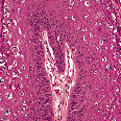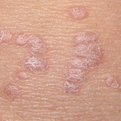Verruca Vulgaris
General Information
Verruca vulgaris, also known as common warts, is a benign skin growth caused by a viral infection in the skin. The human papilloma virus (HPV), which is a double-stranded, circular, supercoiled DNA virus enclosed in an icosahedral capsid and comprising 72 capsomers, causes the warts. There are more then 70 genotypes of HPV, the genotypes are referred by numbers. HPV-2 and HPV-4 are the most common type to cause verruca vulgaris; other subtypes that may cause the warts include HPV-1, HPV-3, HPV-27 and HPV-57. Warts are common in childhood and are spread by direct contact or autoinoculation. Verruca vulgaris typically occurs on the back of fingers or toes and on the knees. Treatment is recommended for patients with extensive, spreading, or symptomatic warts or warts that have been present for more than 2 years. Treatment methods include topical agents, intralesional injections, systemic agents, cryotherapy, laser, electrodessication and surgical excision.
Epidemiology
Widespread in the worldwide population, affects approximately 7-12%
Etiology
Human papilloma virus
Pathogenesis
Non-cancerous skin growth on top layer of skin
Clinical
Hyperkeratotic papules with a rough, irregular surface ranging from < 1 mm to >1 cm
Histology
Digitated epidermal hyperplasia, acanthosis, papillomatosis, compact orthokeratosis, hypergranulosis, dilated tortuous capillaries within the dermal papillae, and vertical tiers of parakeratotic cells with entrapped red blood cells above the tips of the digitations.
Bibliography
1. “Warts, Nongenital” (Online). February 2007. http://emedicine.com/derm/topic457.htm (visited: April 7, 2008) 2. “Common warts” (Online). February 2008. http://www.mayoclinic.com/health/common-warts/DS00370/DSECTION=1 (visited: April 7, 2008)
Download PDF
![]() Verruca Vulgaris
Verruca Vulgaris


